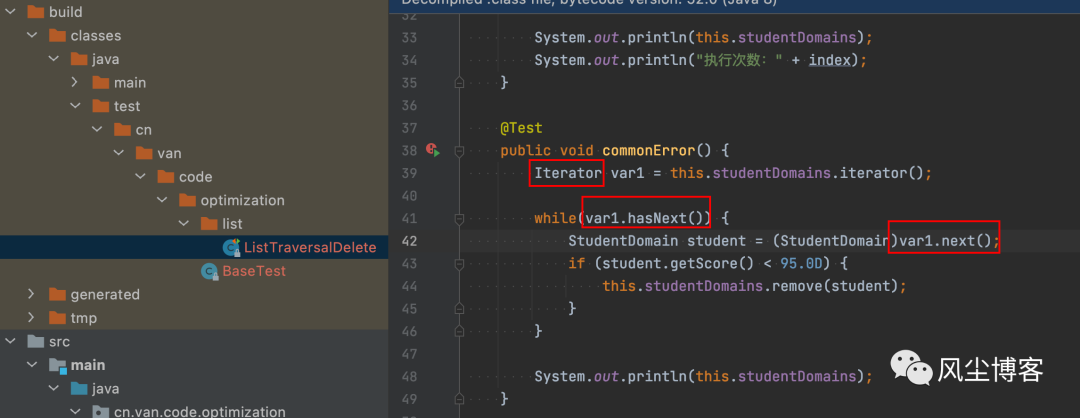一、犯错经历
1.1 故事背景
最近有个需求大致的背景类似:
我已经通过一系列的操作拿到一批学生的考试成绩数据,现在需要筛选成绩大于
95
分的学生名单。
善于写 bug
的我,三下五除二完成了代码的编写:
@Test
public void shouldCompile() {
for (int i = 0; i < studentDomains.size(); i++) {
if (studentDomains.get(i).getScore() < 95.0) {
studentDomains.remove(studentDomains.get(i));
}
}
System.out.println(studentDomains);
}复制
测试数据中四个学生,成功筛选出了两个 95
分以上的学生,测试成功,打卡下班。
[StudentDomain{id=1, name='李四', subject='科学', score=95.0, classNum='一班'}, StudentDomain{id=1, name='王六', subject='科学', score=100.0, classNum='一班'}]复制
1.2 貌似,下不了班!
从业
X
年的直觉告诉我,事情没这么简单。
但是自测明明没问题,难道写法有问题?那我换个写法(增强的 for
循环):
@Test
public void commonError() {
for (StudentDomain student : studentDomains) {
if (student.getScore() < 95.0) {
studentDomains.remove(student);
}
}
System.out.println(studentDomains);
}复制
好家伙,这一试不得了,直接报错:ConcurrentModificationException
。
普通 for
循环“没问题”,增强for
循环有问题,难道是【增强for
循环】的问题?
1.3 普通 for 循环真没问题吗?
为了判断普通 for
循环是否有问题,我将原代码加了执行次数的打印:
@Test
public void shouldCompile() {
System.out.println("studentDomains.size():" + studentDomains.size());
int index = 0;
for (int i = 0; i < studentDomains.size(); i++) {
index ++;
if (studentDomains.get(i).getScore() < 95.0) {
studentDomains.remove(studentDomains.get(i));
}
}
System.out.println(studentDomains);
System.out.println("执行次数:" + index);
}复制
这一加不得了,我的 studentDomains.size()
明明等于 4
,怎么循环体内只执行了 2
次。
更巧合的是:执行的两次循环的数据,刚好都符合我的筛选条件,故会让我错以为【需求已完成】。
二、问题剖析
一个个分析,我们先看为什么普通 for
循环比我们预计的执行次数要少。
2.1 普通 for 循环次数减少
这个原因其实稍微有点儿开发经验的人应该都知道:在循环中删除元素后,List
的索引会自动变化,List.size()
获取到的 List
长度也会实时更新,所以会造成漏掉被删除元素后一个索引的元素。
比如:循环到第
1
个元素时你把它删了,那么第二次循环本应访问第2
个元素,但这时实际上访问到的是原来List
的第3
个元素,因为第1
个元素被删除了,原来的第3
个元素变成了现在的第2
个元素,这就造成了元素的遗漏。
2.2 增强 for 循环抛错
我们先看 JDK
源码中ArrayList
的remove()
源码是怎么实现的:
public boolean remove(Object o) {
if (o == null) {
for (int index = 0; index < size; index++)
if (elementData[index] == null) {
fastRemove(index);
return true;
}
} else {
for (int index = 0; index < size; index++)
if (o.equals(elementData[index])) {
fastRemove(index);
return true;
}
}
return false;
}复制
只要不为空,程序的执行路径会走到 else
路径下,最终调用 fastRemove()
方法:
private void fastRemove(int index) {
modCount++;
int numMoved = size - index - 1;
if (numMoved > 0)
System.arraycopy(elementData, index+1, elementData, index, numMoved);
elementData[--size] = null;
}复制
在 fastRemove()
方法中,看到第 2
行【把 modCount
变量的值加 1
】。
增强 for
循环实际执行

通过编译代码可以看到:增强 for
循环在实际执行时,其实使用的是Iterator
,使用的核心方法是 hasnext()
和 next()
。
而 next()
方法调用了 checkForComodification()
:
final void checkForComodification() {
if (modCount != expectedModCount)
throw new ConcurrentModificationException();
}复制
看到 throw new ConcurrentModificationException()
那么就可以结案了:
因为上面的 remove()
方法修改了 modCount
的值,所以这里肯定会抛出异常。
三、正确方式
既然知道了普通 for
循环和增强 for
循环都不能用的原因,那么我们先从这两个地方入手。
3.1 优化普通 for 循环
我们知道使用普通
for
循环有问题的原因是因为数组坐标发生了变化,而我们仍使用原坐标进行操作。
移除元素的同时,变更坐标。
@Test
public void forModifyIndex() {
for (int i = 0; i < studentDomains.size(); i++) {
StudentDomain item = studentDomains.get(i);
if (item.getScore() < 95.0) {
studentDomains.remove(i);
// 关键是这里:移除元素同时变更坐标
i = i - 1;
}
}
System.out.println(studentDomains);
}复制
倒序遍历
采用倒序的方式可以不用变更坐标,因为:后一个元素被移除的话,前一个元素的坐标是不受影响的,不会导致跳过某个元素。
@Test
public void forOptimization() {
List<StudentDomain> studentDomains = genData();
for (int i = studentDomains.size() - 1; i >= 0; i--) {
StudentDomain item = studentDomains.get(i);
if (item.getScore() < 95.0) {
studentDomains.remove(i);
}
}
System.out.println(studentDomains);
}复制
3.2 使用 Iterator 的 remove()
@Test
public void iteratorRemove() {
Iterator<StudentDomain> iterator = studentDomains.iterator();
while (iterator.hasNext()) {
StudentDomain student = iterator.next();
if (student.getScore() < 95.0) {
iterator.remove();
}
}
System.out.println(studentDomains);
}复制
你肯定有疑问,为什么迭代器的 remove()
方法就可以呢,同样的,我们来看看源码:
public void remove() {
if (lastRet < 0)
throw new IllegalStateException();
checkForComodification();
try {
ArrayList.this.remove(lastRet);
cursor = lastRet;
lastRet = -1;
expectedModCount = modCount;
} catch (IndexOutOfBoundsException ex) {
throw new ConcurrentModificationException();
}
}复制
我们可以看到:每次执行 remove()
方法的时候,都会将 modCount
的值赋值给 expectedModCount
,这样 2
个变量就相等了。
3.3 Stream 的 filter()
了解 Stream
的童鞋应该都能想到该方法,这里就不过多赘述了。
@Test
public void streamFilter() {
List<StudentDomain> studentDomains = genData();
studentDomains = studentDomains.stream().filter(student -> student.getScore() >= 95.0).collect(Collectors.toList());
System.out.println(studentDomains);
}复制
3.4 Collection.removeIf()【推荐】
在 JDK1.8
中,Collection
以及其子类新加入了 removeIf()
方法,作用是按照一定规则过滤集合中的元素。
@Test
public void removeIf() {
List<StudentDomain> studentDomains = genData();
studentDomains.removeIf(student -> student.getScore() < 95.0);
System.out.println(studentDomains);
}复制
看下 removeIf()
方法的源码,会发现其实底层也是用的 Iterator
的remove()
方法:
default boolean removeIf(Predicate<? super E> filter) {
Objects.requireNonNull(filter);
boolean removed = false;
final Iterator<E> each = iterator();
while (each.hasNext()) {
if (filter.test(each.next())) {
each.remove();
removed = true;
}
}
return removed;
}复制
四、总结
详细认真的看完本文的话,最大感悟应该是:还是源码靠谱!
4.1 啰嗦几句
其实在刚从事 Java
开发的时候,这个问题就困扰过我,当时只想着解决问题,所以采用了很笨的方式:
新建一个新的
List
,遍历老的List
,将满足条件的元素放到新的元素中,这样的话,最后也完成了当时的任务。
现在想一想,几年前,如果就像现在一样,抽空好好想想为什么不能直接 remove()
,多问几个为什么,估计自己会比现在优秀很多吧。
当然,只要意识到这个,什么时候都不算晚,共勉!
4.2 文中代码示例
Github/vanDusty: https://github.com/vanDusty/JDK/tree/master/code-optimization






